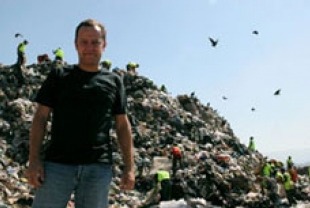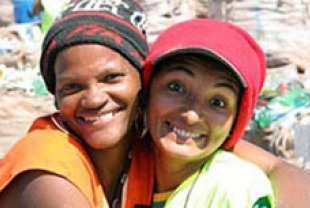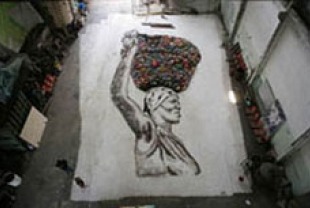In the early 1970s we put together a program called "Feedforward" which was designed for youth in mainline Protestant communities across the country. Kids would select their favorite rock songs and then share some of the themes and ideals that interested them. We took the group to a local dump where they gathered objects which spoke to them. Many of the kids were surprised by the things they discovered. During this time, professional artists were creating works for museums out of everyday "found objects" that had been rejected and deemed worthless by society; when displayed alone or in tandem with other objects, these cast-offs sometimes revealed their inner beauty. Working with similar materials, the youth in Feedforward changed their ideas about their possessions and those objects they took for granted. At the end of the program, the kids chose a theme and created a junk sculpture illustrating it.
Watching Waste Land brought to mind these adventures with found objects. This astonishing documentary directed by Lucy Walker focuses on the art of Brazilian-born, Brooklyn-based artist and innovator Vic Muniz, who uses garbage as an art medium:
"The beautiful thing about garbage is that it is negative: it's something that you don't use anymore; it's what you don't want to see. So if you are a visual artist, it becomes very interesting material to work with because it's the most nonvisual of materials. You are working with something that you usually try to hide."
At the beginning of Waste Land, Muniz is preparing to travel to Jardim Gramacho, the world's largest garbage dump located on the outskirts of Rio de Janeiro. An estimated 3,000 to 5,000 people live in the dump and 15,000 earn their living laboring there in the burning sun and piercing stench. Every day, the pickers, or catadores, sort through the mountains of garbage for recyclable materials that they can sell. Some families have worked in Jardim Gramacho for three generations. In this strange milieu, Muniz hopes to create something beautiful.
He's comes up with an unusual method and style of painting that involves the catadores' participation. Among those he befriends and collaborates with are Irma, a selfless cook who sells food at the dump; Zumbi, the reader of many salvaged books; Suelem, an 18-year-old who has been sweating in Jardim Gramacho since she was seven; and Valter, the landfill elder statesman. Muniz, who was poor at one time in his life, is especially impressed with the courage and perseverance of Tiao, the young founder of the catadores cooperative. Although these pickers live on the margins of society and are considered as disposable as the garbage they handle, Muniz is gratified to learn that many of the men enjoy the work and some of the women see it as the only alternative to prostitution.
After viewing Waste Land, you may no longer want or be able to exclude anything or anybody from your heart. Now there's a spiritual ideal! We cannot dismiss even garbage because, as Muniz and his collaborators show us, there is beauty to be found there. We cannot exclude poor people by labeling them as worthless and lazy. Even in a dark, smelly, and terrible place like Jardim Gramacho, healing and helpful things can be done to save the environment for future generations through recycling. Here art, so often considered an elitist pastime for the aristocracy, is a means of bringing all people together and saluting the oneness of our humanity. Don't miss Waste Land, one of the Best Documentaries of 2010!


